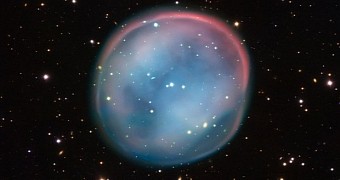A brand new space image delivered by the European Southern Observatory's Very Large Telescope in northern Chile shows what appears to be a ginormous soap bubble floating about the cosmos.
Except there are no such things as soap or aliens with a passion for blowing bubbles in space. Well, at least as far as we know.
In fact, the image, available next to this article, reveals a planetary nebula nicknamed the Southern Own Nebula. Its more official monikers are ESP 378-1, PN K 1-22 and PN G283.6+25.3.
The planetary nebula sits in the constellation of Hydra. Unlike other planetary nebulae that are rather dysmorphic, the Southern Own Nebula is a nearly perfect sphere expanding 4 light-years across.
“Nicknamed the Southern Owl Nebula, this shimmering orb is a planetary nebula with a diameter of almost 4 light-years,” astronomers explain.
The view of this planetary nebula that scientists at the European Southern Observatory released earlier this week is the clearest and the most detailed yet obtained.
How the Southern Owl Nebula came into being
It might look positively stunning, but the Southern Owl Nebula is, in fact, a corpse. The corpse of a dying star that, having reached the end of its life, shed its outer layers into its surroundings.
In turn, the ejected material expanded and formed the sphere that appeared as a mammoth cosmic bubble to the European Southern Observatory's Very Large Telescope.
The star that created this bubble-shaped cloud of material must have been about 8 times smaller than our Sun. Otherwise, it would have exploded in a supernova and put on a far more impressive show.
Astronomers expect that, in a few thousand years, the Southern Own Nebula will begin to fade and eventually vanish without a trace.
“After the planetary nebula has faded away, the leftover stellar remnant will burn for another billion years before consuming all its remaining fuel,” they say.
Once all its fuel is gone, the star will turn into a hot and dense white dwarf. Billions of years later, it will begin to cool and disappear as well.

 14 DAY TRIAL //
14 DAY TRIAL //